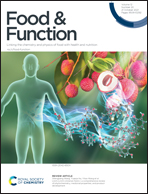Hypoglycemic and lipid lowering effects of theaflavins in high-fat diet-induced obese mice†
Abstract
Theaflavins (TFs) are the characteristic components of black tea and have been widely acknowledged for their health benefits. The current study aimed to investigate the effects and mechanism of TFs, TF1, TF2a and TF3 on glycolipid metabolism in obese mice induced by a high-fat diet (HFD). Mice were randomly divided into seven groups (n = 8 per group) as follows: low-fat diet (LFD), HFD, HFD + metformin (Met, 100 mg kg−1 d−1), HFD + TFs (TFs, 200 mg kg−1 d−1), HFD + TF1 (TF1, 100 mg kg−1 d−1), HFD + TF2a (TF2a, 100 mg kg−1 d−1), and HFD + TF3 (TF3, 100 mg kg−1 d−1). All groups were studied for 9 weeks continuously. The levels of serum glucose, insulin, TC, TG, LDL and HLD in the plasma, lipid accumulation in the liver, and injury of the liver were investigated. In addition, the effects of TFs and their monomers on the SIRT6/AMPK/SREBP-1/FASN pathway were also evaluated. The results showed that oral administration of TFs, TF1, TF2a and TF3 not only dramatically suppressed weight gain, reduced blood glucose level, and ameliorated insulin resistance but also obviously lowered the levels of serum TC, TG and LDL, suppressed the activities of ALT and AST, and ameliorated hepatic damage in mice fed a HFD when compared to the HFD group. Western blot analysis showed that TFs, TF1, TF2a and TF3 treatments increased the expression of SIRT6 and suppressed the expression levels of SREBP-1 and FASN significantly in mice fed a HFD as compared to the HFD group. The phosphorylation of AMPK in mice fed a HFD was obviously elevated by TF2a and TF3 when compared to the HFD group. These results proved for the first time that TF1, TF2a and TF3 improved the glucolipid metabolism of mice fed a HFD, and activated the SIRT6/AMPK/SREBP-1/FASN signaling pathway to inhibit the synthesis and accumulation of lipids in the liver to ameliorate obesity in mice fed a HFD. These findings indicate that TFs, TF1, TF2a and TF3 as the main functional components of black tea might potentially be used as a food additive for improving glycolipid metabolism and ameliorating obesity, and TF3 may be the best choice.



 Please wait while we load your content...
Please wait while we load your content...